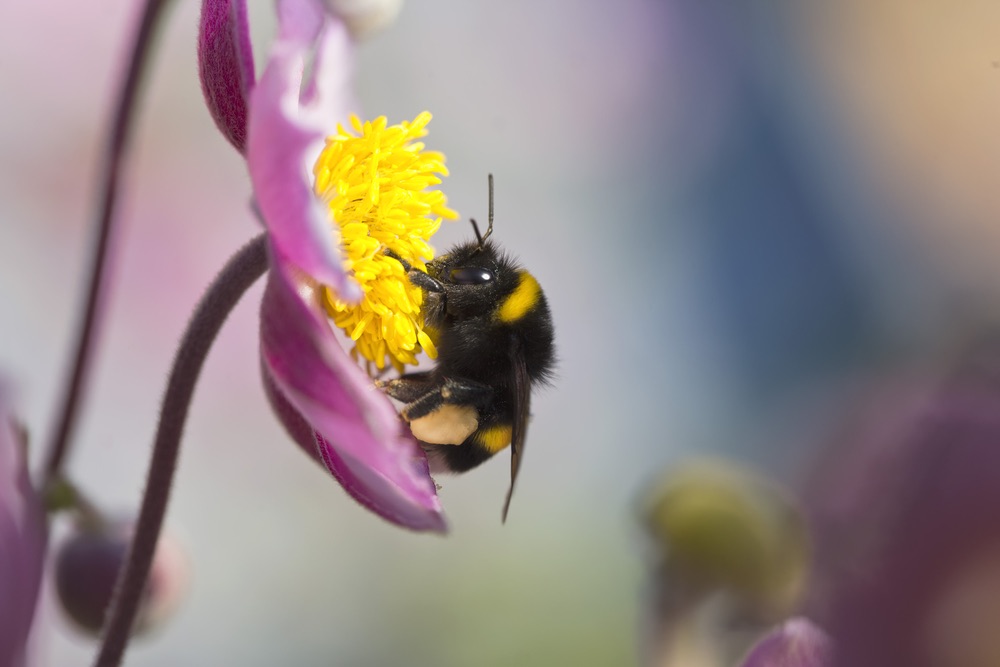Bumblebees Leave 'Smelly Footprints' Behind on Flowers

Bumblebees mark the flowers they've visited with smelly footprints, and they can tell the difference between odors from family members' feet and those of strangers, researchers have found.
By sniffing out these dainty footprints, bumblebees can locate good food and steer clear of flowers whose nutrients have been depleted, the scientists reported in a new study.
"Bumblebees secrete a substance whenever they touch their feet to a surface, much like us leaving fingerprints on whatever we touch," Richard Pearce, a scientist at the University of Bristol in the United Kingdom, said in a statement. [Watch Bumblebees Learn to Roll Balls, Earn Rewards | Video]
In the study, Pearce and his colleagues ran three experiments in which they gave buff-tailed bumblebees (Bombus terrestris) the choice of four "flowers," which were containers filled with either sucrose (rewarding flowers) or water (unrewarding flowers). In the experiments, these flowers contained smelly footprints from the bee itself, footprints from a "stranger" bee from another nest or footprints from a nest mate. In some of the experiments, some flowers contained no scent marks.
In one experiment, the bees were trained to discriminate between flowers scent-marked by nest mates versus non-nest mates. During the training phase, the nest-mate flowers contained sucrose, and the "stranger" flowers held water. Then, in follow-up tests in which all of the flowers contained water, the researchers found that the bees could distinguish between the two: They spent more time on flowers scent-marked by nest mates (which they had learned were rewarding during the training phase) than on flowers associated with footprints from the strangers.
In another experiment, the bees learned that flowers with nest-mate footprints were rewarding (i.e., contained sucrose) and that flowers with their own scent marks were unrewarding (i.e., contained water). Then, during the test run, all of the flowers contained water. The bumblebees ended up spending more time on the unrewarding flowers that smelled like their nest mates.
"Because the flowers all contained water, when the bees were being tested, they would often stay on the flowers scent-marked by nest mates (previously rewarding) searching for nectar, as they were used to finding it in these flowers during training," Pearce wrote in the email.
Sign up for the Live Science daily newsletter now
Get the world’s most fascinating discoveries delivered straight to your inbox.
The researchers said they can't be certain how, exactly, the bumblebees use the smelly footprints to target certain flowers in the wild. The footprints left by a nest mate could suggest that the flower is empty of nectar and that the foraging bumblebee should bumble down the road, or it could be that the particular flower holds a tasty meal.
"It may be that other bumblebees visited some flowers a different length of time ago compared to the bee searching for nectar, which may affect the amount of nectar in the flowers," Pearce told Live Science in an email. "Or even that other bees take less or more of the nectar than the bee searching for nectar would. So being able to distinguish between the different types of scent-marks might help a bumblebee to select flowers with more nectar inside."
He added that the scent marks could also tell a bee which flowers it has already visited and which flowers were visited by others. All of this information can help a bumblebee decide where to seek its next nectar meal.
Not only can bumblebees detect their own scent-mark, they can also discriminate between that and scent-marks
of their nestmates, as well as between scent-marks of their nestmates and scent-marks of non-nestmates.
"Not only can bumblebees detect their own scent-mark, they can also discriminate between that and scent-marks of their nestmates, as well as between scent-marks of their nestmates and scent-marks of non-nestmates," Pearce and his colleagues wrote online today (March 7) in the journal Scientific Reports.
Original article on Live Science.
Jeanna Bryner is managing editor of Scientific American. Previously she was editor in chief of Live Science and, prior to that, an editor at Scholastic's Science World magazine. Bryner has an English degree from Salisbury University, a master's degree in biogeochemistry and environmental sciences from the University of Maryland and a graduate science journalism degree from New York University. She has worked as a biologist in Florida, where she monitored wetlands and did field surveys for endangered species, including the gorgeous Florida Scrub Jay. She also received an ocean sciences journalism fellowship from the Woods Hole Oceanographic Institution. She is a firm believer that science is for everyone and that just about everything can be viewed through the lens of science.










